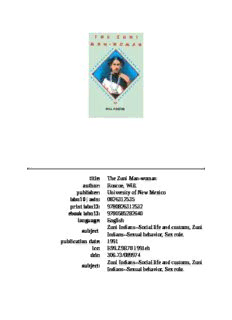
The Zuni man-woman PDF
Preview The Zuni man-woman
title: The Zuni Man-woman author: Roscoe, Will. publisher: University of New Mexico isbn10 | asin: 0826312535 print isbn13: 9780826312532 ebook isbn13: 9780585282640 language: English Zuni Indians--Social life and customs, Zuni subject Indians--Sexual behavior, Sex role. publication date: 1991 lcc: E99.Z9R78 1991eb ddc: 306.73/089974 Zuni Indians--Social life and customs, Zuni subject: Indians--Sexual behavior, Sex role. Page iii The Zuni Man-Woman Will Roscoe Page iv Library of Congress Cataloging-in-Publication Data Roscoe, Will. The Zuni man-woman/Will Roscoe.1st ed. p. cm. Includes bibliographical references and index. ISBN 0-8263-1253-5 1. Zuni Indians-Social life and customs. 2. Zuni Indians-Sexual behaviour. 3. Sex role. 1. Title E99.Z9R78 1991 306.73'089974dc20 Design by Susan Gutnik. © 1991 Will Roscoe. All rights reserved. Second paperbound printing, 1996 Page v Contents Preface vii Acknowledgements xix Prologue 1 A Death that caused Universal Regret Chapter One 7 The Middle Place Chapter Two 29 We'wha, the Celebrated Lhamana Chapter Three 53 Among the Most Enlightened Society Chapter Four 98 The Country was full of Soldiers Chapter Five 123 The Rites of Gender Chapter Six 147 Two-fold One-kind Chapter Seven 170 They Left this Great Sin Chapter Eight 195 The Berdache Tradition Appendix One 215 Pronunciation Guide Appendix Two 217 The Beginning Page vi Notes 223 Bibliography 267 Index 291 Tables Table 1. Correspondences of the Zuni Origin Myth 150 Table 2. Kan'a:kwe Synonymy 155 Page vii Preface The Genesis of The Zuni Man-Woman dates back to 1982, when I spent several months in the home of my friend and colleague Harry Hay. 1 Hay gave me access to notes and source materials from his extensive historical and cross-cultural research on homosexuality and alternative gender roles, conducted in the 1950s and early 1960s. As I discovered, Hay had come to view the American Indian berdache role as an example of a socially approved channel for the expression of a pattern of sex and gender variance that allowed individuals to make unique social, religious, and artistic contributions to their communities. In the 1960s, however, he interrupted this research to shift his energies to political organizing on behalf of American Indian causes. As a result, most of his insights and discoveries concerning this subject remain unpublished. With Hay's encouragement, I decided to begin my own study of alternative gender roles. My approach from the outset was less theoretical than his and more in the vein of contemporary ethnohistory, which combines the methods of history and anthropology. I hoped to find specific cultural contexts with enough documentation to reconstruct not only the social and conceptual dimensions of alternative gender roles, but the lives of the individuals who occupied them as well. When I joined Hay and a small group of friends in New Mexico in 1983, however, I had not yet decided on a Page viii specific tribe to study. But after witnessing dances at four Pueblo villages, visiting the homes of Hay's friends at San Juan and San Ildefonso, clambering about ancient mesa-top ruins, and acquiring an appreciation for Pueblo art and architecture, I had little doubt regarding the direction my research would take. In this landwhere the high point of the day for Indian, Hispanic, and Anglo residents alike consists of pulling up a chair to watch afternoon thunderclouds streak the horizons or the setting sun dissolve in spectacular opulenceI experienced the same awe of natural surroundings I had known while growing up in western Montana. I also found another, equally important source of inspiration in New Mexico's rich cultural diversity, the kind of diversity that had led me to resettle some years ago in the San Francisco Bay Area. The wealth of published documentation on Zuni culture and history led me to focus my studies on that tribe. Even so, I had little inkling of the abundance of unpublished and oral sources that would enable me to tell the life story of a particular male berdache, We'wha, in remarkable detail. Nor did I foresee the extensive visual resources that would allow me to compile a slide-lecture program, "The Zuni Man- Woman," which I have since presented throughout the United States and Canada. Initially, I imagined the outcome of my research would be an article, but I soon found myself stymied by the very abundance of the resources that had led me to single out Zuni. I began pursuing separate questions in far-flung aspects of Zuni cultureanalyzing locational references in myths and ceremonies; studying gender symbolism on kachinas; reconstructing the sexual politics of Zuni prehistory; compiling biographical background on key figures in Zuni history; studying the Zuni language. Gradually, as I became better acquainted with the philosophy underlying the diversity of Zuni cultural expressions, new sources began falling into familiar patterns. I also took advantage of the wealth of sources to cross-check statements by one observer with those of others. By following this procedure I was able to avoid excessive reliance on either of the two early anthropologists, Frank Hamilton Cushing and Matilda Coxe Stevenson, whose work still dominates the field of Zuni studies. In the spring of 1984, efforts to locate the source of a photograph of We'wha led me to the collections of the Southwest Museum and
Description: